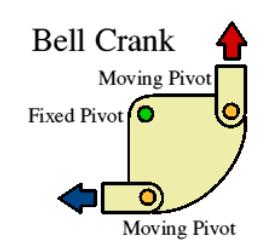Bell Crank: Difference between revisions
From DT Online
(Changed link) |
(Added Template) |
||
| Line 1: | Line 1: | ||
[[File:MechanismsBellCrank.jpg| | [[File:MechanismsBellCrank.jpg|300px|right]] | ||
__TOC__ | |||
=====Description===== | |||
If an ‘L’-shaped '''[[Class of Lever|lever]]''' is pivoted at its centre, the direction of the input movement or force would be turned through 90° at the output. This '''[[:Category:Linkages|linkage]]''' is known as a '''[https://en.wikipedia.org/wiki/Bellcrank '''Bell Crank''']''' ''(so called because it was used in Victorian times in linkages used to operate doorbells and servants' bells)''. They can be used to change the angle of motion through any angle but 90° is common. | If an ‘L’-shaped '''[[Class of Lever|lever]]''' is pivoted at its centre, the direction of the input movement or force would be turned through 90° at the output. This '''[[:Category:Linkages|linkage]]''' is known as a '''[https://en.wikipedia.org/wiki/Bellcrank '''Bell Crank''']''' ''(so called because it was used in Victorian times in linkages used to operate doorbells and servants' bells)''. They can be used to change the angle of motion through any angle but 90° is common. | ||
=====Features and Uses===== | |||
A common device which uses this mechanism is the brake caliper on a bicycle. Here the force from the handlebar lever is turned through 90° to squeeze the brake block against the wheel rim. | A common device which uses this mechanism is the brake caliper on a bicycle. Here the force from the handlebar lever is turned through 90° to squeeze the brake block against the wheel rim. | ||
If the fulcrum or pivot is at an equal distance from the input and output then the movement of the output will be equal to the movement of the input. Otherwise the movement will be different and the system will have some degree of '''[[Mechanical Advantage]]'''. | If the fulcrum or pivot is at an equal distance from the input and output then the movement of the output will be equal to the movement of the input. Otherwise the movement will be different and the system will have some degree of '''[[Mechanical Advantage]]'''. | ||
{{Construction Kits Buyers Guide}} | |||
Revision as of 08:41, 1 June 2016
Description
If an ‘L’-shaped lever is pivoted at its centre, the direction of the input movement or force would be turned through 90° at the output. This linkage is known as a Bell Crank (so called because it was used in Victorian times in linkages used to operate doorbells and servants' bells). They can be used to change the angle of motion through any angle but 90° is common.
Features and Uses
A common device which uses this mechanism is the brake caliper on a bicycle. Here the force from the handlebar lever is turned through 90° to squeeze the brake block against the wheel rim.
If the fulcrum or pivot is at an equal distance from the input and output then the movement of the output will be equal to the movement of the input. Otherwise the movement will be different and the system will have some degree of Mechanical Advantage.
|
Click top left to enlarge |









